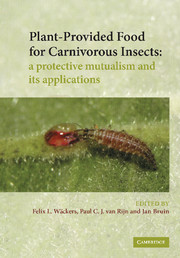Book contents
- Frontmatter
- Contents
- List of contributors
- Foreword by Peter W. Price
- 1 Food for protection: an introduction
- PART I FOOD PROVISION BY PLANTS
- PART II ARTHROPODS FEEDING ON PLANT-PROVIDED FOOD
- PART III PLANT-PROVIDED FOOD AND BIOLOGICAL CONTROL
- 8 Impact of plant-provided food on herbivore–carnivore dynamics
- 9 Does floral nectar improve biological control by parasitoids?
- 10 Habitat diversification in biological control: the role of plant resources
- 11 Providing plant foods for natural enemies in farming systems: balancing practicalities and theory
- Index
- References
10 - Habitat diversification in biological control: the role of plant resources
Published online by Cambridge University Press: 15 December 2009
- Frontmatter
- Contents
- List of contributors
- Foreword by Peter W. Price
- 1 Food for protection: an introduction
- PART I FOOD PROVISION BY PLANTS
- PART II ARTHROPODS FEEDING ON PLANT-PROVIDED FOOD
- PART III PLANT-PROVIDED FOOD AND BIOLOGICAL CONTROL
- 8 Impact of plant-provided food on herbivore–carnivore dynamics
- 9 Does floral nectar improve biological control by parasitoids?
- 10 Habitat diversification in biological control: the role of plant resources
- 11 Providing plant foods for natural enemies in farming systems: balancing practicalities and theory
- Index
- References
Summary
Introduction
Modern agricultural production practices frequently lead to the simplification of agricultural landscape structure. When landscapes are developed for agricultural uses, it is common for the prior ecosystems to be highly fragmented or completely replaced by relatively simple habitats dominated by a few plant species (Merriam 1988; Pogue and Schnell 2001). This process has generally intensified in the last half century due to increased use of mechanization and chemical inputs. As a consequence of both landscape simplification and intensive use of pesticides, predator and parasitoid populations that may otherwise suppress herbivore populations can be rendered inefficient. Recently, there has been significant interest in diversifying agricultural landscapes to benefit natural enemy communities, reduce reliance on pesticides, and increase agricultural sustainability (Altieri and Letourneau 1982; Pickett and Bugg 1998; Gurr et al. 2000; Landis et al. 2000). Typically these practices focus on providing specific resources to natural enemies through selective addition of habitats to the crop and surrounding environment. Such habitats are designed to provide natural enemies with appropriate food and shelter, and are typically accomplished by manipulation of plant species, populations, or communities, and the resources that they provide. At the same time, these habitats need to deny similar benefits to herbivores.
Habitat diversification benefits natural enemies in a variety of ways. Resources may be provided directly (e.g., floral nectar, pollen), indirectly (e.g., increased host or prey availability), or as emergent properties of habitat diversification (e.g., moderated microclimates).
- Type
- Chapter
- Information
- Plant-Provided Food for Carnivorous InsectsA Protective Mutualism and its Applications, pp. 305 - 325Publisher: Cambridge University PressPrint publication year: 2005
References
- 11
- Cited by

